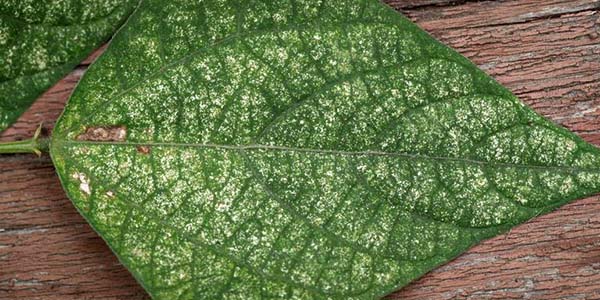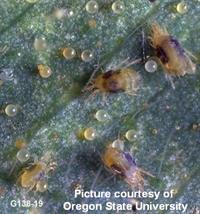AGRONOMICSUPPORT
YOU CAN TAKETO THE FIELD
How to Control Two Spotted Spider Mites
Two spotted spider mites may be a concern in some areas of Iowa this year with current drought conditions. They are also likely present in other areas of the corn belt that have had similar weather patterns. Hot and dry weather favors rapidly expanding populations of the pest. Spider mites are very difficult to see with the naked eye.
Indications of Two Spotted Spider Mites
The first visual indication you’ll notice is discolored/yellowing leaves along field edges, waterways, roadsides, etc. Spider mites overwinter in these areas as eggs and will rapidly expand into soybean fields when the environment is favorable. You might notice a “V” shaped area of damage moving out into the field where the population is growing. They live on the undersides of leaves and suck the juices from leaf tissue, resulting in a burned look or stippling.
How to Determine Active Two Spotted Spider Mites
To determine if you have an active population, go to the field edges or areas that show yellowing symptoms. Hold white pieces of paper low in the canopy and shake the plants. Look for tiny dark spots moving on the paper. A hand magnifying lens is very useful in identifying the tiny spider mites. You’ll also see faint white webbing on the underside of leaves.
Treating Two Spotted Spider Mites
Before deciding whether to spray a rescue treatment or not, you need to look at the weather forecast. A good rain shower will do wonders for controlling them! Not only does it wash them off, so to speak, but the moist environment encourages development of beneficial fungi and other insects that prey on the mites. If you have a 7-10 day forecast of continued hot and dry, it’s time to act. If caught early enough, you might be able to get away with just spraying field edges. If your scouting has found them more widely spread, a whole field treatment is best. Waiting too long to make a treatment can also lead to a buildup of egg populations, which will mean a continuous re-supply of spider mites and possibly require a retreatment.
Yield Loss from Two Spotted Spider Mites
There is limited information from universities on economic thresholds. In heavy infestations yield loss will be significant. The rule of thumb is if you’ve identified an expanding population and the weather is favorable for that to continue, then spray. Both University of Minnesota and Ohio State University have developed treatment guidelines. The guidelines from both universities recommend treatment once most plants show stippling and yellowing on the lower leaves and most plants are infested with mites. It is recommended to use a full rate of an organophosphate insecticide, as they have great control of spider mites and aren’t detrimental to beneficial mite predators.
If you have any question or want assistance in diagnosing a field, please contact an LG Seeds STAR Partner or Technical Team Agronomist.
This technical bulletin is a recap of a previously written blog, available here.
Sources and additional information:
Whitney Cranshaw, Colorado State University, Bugwood.org
https://crops.extension.iastate.edu/cropnews/2020/07/scouting-reminders-spider-mites
https://extension.umn.edu/pest-management/twospotted-spider-mites-soybean








Technical Team Agronomist